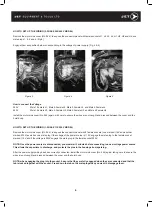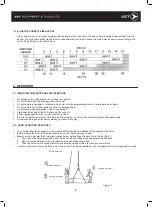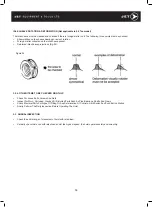
9
1.4.2. USE THE CORRECT SIZE BUCKET
• If the chain bucket is too small compared with the length of the load chain, the load chain will dangerously overflow from the
bucket. Too big a chain bucket tends to be pushed upward by the load. Choose the correct size bucket corresponding to the
hoist’s lift by refering to the table below:
2. OPERATION
2.1. IMPORTANT INSTRUCTIONS FOR OPERATORS
• Do not use hoist to lift people or carry loads over people
• Do not lift more than the rated capacity of the hoist
• Do not operate a damaged or malfunctioning hoist until necessary adjustments or repairs have been made
• Do not operate hoist with a twisted, kinked or damaged chain
• Do not leave a load suspended in the air unattended
• Align hoist for a straight line lift. Avoid side lift or end lift
• Avoid jogging push buttons or quick reversing of load
• Be sure to use the hook latch. If the latch is malfunctioning, do not use the hoist until repairs have been made.
• Do practice daily inspection before starting operation every day
2.2. GOOD OPERATING PRACTICES
• The operator should not engage in any practice which will divert his attention while operating the hoist.
• Before starting the hoist, the operator should be certain that all personel is clear.
• Make it a rule to perform the 3 important checks below, before lifting the load high in the air. (Fig.11)
1. First, check the slinging position, when the load chain and lifting slings becomes stretched tight.
2. Next, check the balance of the load while only inches above the ground.
3. Then check the hoist’s braking function by operating up and down a few inches several times.
• If you are uncertain or feel something is not correct, lower the load immediately, and investigate what is not operating correctly.
Slinging is all right!
Balance is all right!
Before lifting high ...
Braking is all right!
Figure 11























